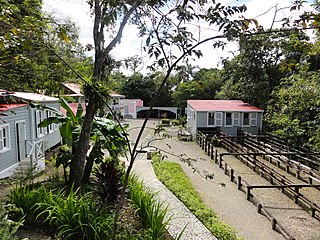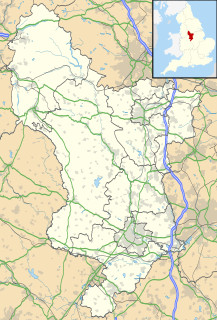 W
WCoffee production is the industrial process of converting the raw fruit of the coffee plant into the finished coffee. The coffee cherry has the fruit or pulp removed leaving the seed or bean which is then dried. While all green coffee is processed, the method that is used varies and can have a significant effect on the flavor of roasted and brewed coffee. Coffee production is a major source of income for 12.5 million households, most in developing countries.
 W
WCoffee production in Guatemala began to develop in the 1850s. Coffee is an important element of Guatemala's economy.
 W
WThe coffee cycle was a period in Brazil's economic history, beginning in the mid-19th century and ending in 1930, in which coffee was the main product of the Brazilian economy. The coffee cycle succeeded the gold cycle, which had come to an end after the exhaustion of the mines a few decades earlier, and put an end to the economic crisis generated by this decadence.
 W
WCoffee production in Guadeloupe, an overseas region of France in the Caribbean Sea, has had commercial importance at various times in its history. The island's coffee heritage is being promoted through ecotourism.
 W
WCoffee production in Martinique dates to 1723 and its establishment is credited to the French naval officer Gabriel de Clieu. It later spread to other places in the Caribbean and South America from Martinique, an overseas region of France.
 W
WCoffee varieties are the diverse subspecies derived through selective breeding or natural selection of coffee plants. While there is tremendous variability encountered in both wild and cultivated coffee plants, there are a few varieties and cultivars that are commercially important due to various unique and inherent traits such as disease resistance and fruit yield. These unique traits are what producers use to select breeds when developing crops. Therefore, at a micro level, breed selection is critical to the success of a producer and is one of the key components of cup quality.
 W
WThe Colombian coffee Region, also known as the Coffee Triangle is a part of the Colombian Paisa region in the rural area of Colombia. It is famous for growing and producing the majority of Colombian coffee. There are four departments in the area: Caldas, Quindío, Risaralda and Tolima. The most visited cities are Manizales, Armenia, Pereira, and Ibagué.
 W
WFair trade coffee is coffee that is certified as having been produced to fair trade standards by fair trade organizations, which create trading partnerships that are based on dialogue, transparency and respect, with the goal of achieving greater equity in international trade. These partnerships contribute to sustainable development by offering better trading conditions to coffee bean farmers. Fair trade organizations support producers and sustainable environmental farming practices and prohibit child labor or physical forced labor.
 W
WA fazenda is a plantation found throughout Brazil; during the colonial period. They were concentrated primarily in the northeastern region, where (sugar) was produced, expanding during the 19th century in the southeastern region to coffee production. Fazenda now denotes any kind of farm in Brazilian Portuguese and occasionally in other Portuguese varieties as well.
 W
WAntonio Ferrigno was an Italian painter; best known for his landscapes and genre scenes created during a stay in Brazil.
 W
WHacienda Lealtad also known as Hacienda La Lealtad, and Hacienda la Esperanza is a historic coffee plantation in barrio La Torre, Lares, Puerto Rico. A large hacienda, it was founded in 1830, by Juan Bautista Plumey, a French immigrant, who arrived in Puerto Rico with enslaved people.
 W
WKona Coffee Living History Farm is located on the Daisaku Uchida Coffee Farm, in the Kona District, on the Big Island of Hawaiʻi. The 5.5-acre (22,000 m2) historic Kona coffee farm was established in 1900.
 W
WMuseo Hacienda Buena Vista is a historic coffee plantation farm museum in Barrio Magueyes, Ponce, Puerto Rico. The museum opened in 1986, and receives some 40,000 visitors a year. The museum has been described as "Puerto Rico's first living museum of art and science."
 W
WNestlé Tutbury is a large coffee factory in Derbyshire. It is the longest running Nestlé factory in the world, outside of Switzerland.
 W
WOrganic coffee is coffee produced without the aid of artificial chemical substances, such as certain additives or some pesticides and herbicides.
 W
WThe Oromia Coffee Farmers’ Cooperative Union (OCFCU) is a smallholder farmer owned cooperative union based in the Oromia region of south, central and west Ethiopia. Oromia is the largest of the nine states within Ethiopia and home to Addis Ababa, the capital of Ethiopia. Coffee accounts for approximately thirty-two percent of the value of all merchandise exports and Oromia accounts for more than sixty-five percent of the country’s total coffee growing lands. Furthermore, Oromia is the region where coffee first originated. The region is characterised by its unique native vegetation and tropical climate conducive to coffee bean growth. OCFCU is a democratic, member’s owned business operating under principles of International Cooperative Alliance and Fair trade and the Union plays a central role in the Ethiopian coffee marketing chain. The members of OCFCU grow, process and supply high quality, organic Arabica coffee for export.
 W
WS795 (Selection-795) is a coffee cultivar important for being one of the first strains of C. arabica found to be resistant to coffee leaf rust (CLR).
 W
WShade-grown coffee is a form of the crop produced from coffee plants grown under a canopy of trees. A canopy of assorted types of shade trees is created to cultivate shade-grown coffee. Because it incorporates principles of natural ecology to promote natural ecological relationships, shade-grown coffee can be considered an offshoot of agricultural permaculture or agroforestry. The resulting coffee can be marketed as "shade-grown".
 W
WTerroir is a French term used to describe the environmental factors that affect a crop's phenotype, including unique environment contexts, farming practices and a crop's specific growth habitat. Collectively, these contextual characteristics are said to have a character; terroir also refers to this character.
 W
WThe universal nut sheller is a simple hand-operated machine capable of shelling up to 57 kilograms (126 lb) of raw, sun-dried peanuts per hour.